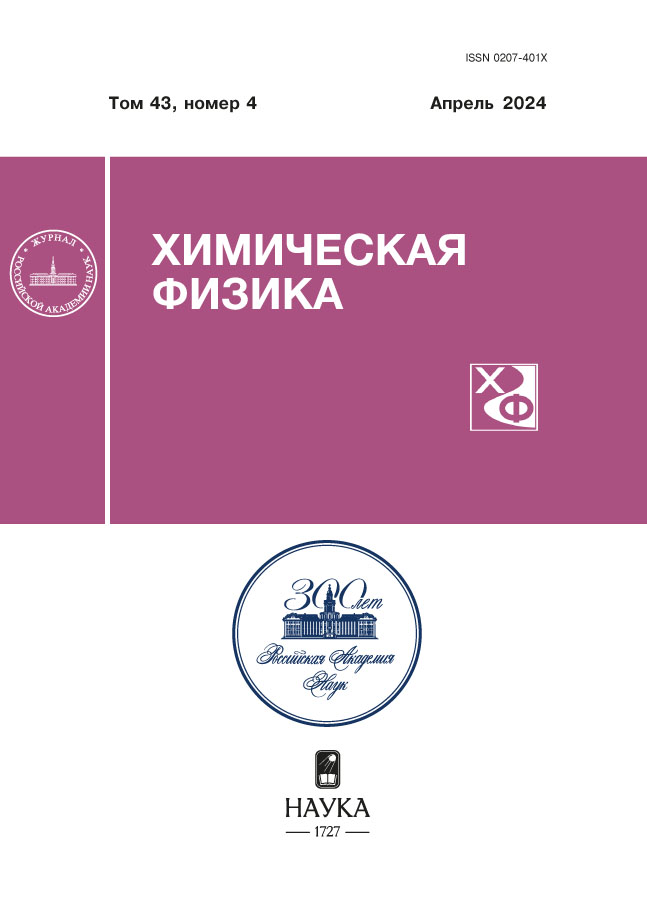The effect of hypochlorite-induced fibrinogen oxidation on the protein structure, fibrin self-assembly and fibrinolysis
- Autores: Yurina L.V.1, Vasilyeva A.D.1, Evtushenko E.G.2, Gavrilina E.S.1, Obydennyi S.I.3,4, Chabin I.A.3,5, Indeykina M.I.1, Kononikhin A.S.6,7, Nikolaev E.N.6,7, Rosenfeld M.A.1
-
Afiliações:
- Emanuel Institute of Biochemical Physics, Russian Academy of Sciences
- Lomonosov Moscow State University
- Dmitry Rogachev National Medical Research Center of Pediatric Hematology, Oncology and Immunology of Ministry of Healthcare of the Russian Federation
- Centre for Theoretical Problems of Physicochemical Pharmacology
- Sechenov First Moscow State Medical University (Sechenov University)
- Talrose Institute for Energy Problems of Chemical Physics, N.N. Semenov Federal Center of Chemical Physics, Russian Academy of Sciences
- Skolkovo Institute of Science and Technology
- Edição: Volume 43, Nº 4 (2024)
- Páginas: 81-87
- Seção: Chemical physics of biological processes
- URL: https://cardiosomatics.ru/0207-401X/article/view/674964
- DOI: https://doi.org/10.31857/S0207401X24040109
- EDN: https://elibrary.ru/VEBMSO
- ID: 674964
Citar
Texto integral
Resumo
The article is dedicated to the structural-functional damage of fibrinogen treated with HOCl in the concentration range (10–100 µM). The MS/MS method detected 15 modified amino acid residues with a dose-dependent susceptibility to the oxidizing agent. Using turbidity measurements and confocal laser scanning microscopy, it has been shown that fibrinogen oxidation by 25–100 µM HOCl leads to the denser fibrin gel formation, as well as delayed polymerization onset and a decrease in the slope of the polymerization curve, presumably due to conformational changes of the protein. At lower HOCl concentration (10 µM), at least six amino acid residues were substantially modified (9–29%), but functionally such modified protein was not distinguishable from the native one. The detected amino acid residues are assumed to be ROS scavengers that prevent fibrinogen functions alteration.
Palavras-chave
Texto integral
Sobre autores
L. Yurina
Emanuel Institute of Biochemical Physics, Russian Academy of Sciences
Autor responsável pela correspondência
Email: lyu.yurina@gmail.com
Rússia, Moscow
A. Vasilyeva
Emanuel Institute of Biochemical Physics, Russian Academy of Sciences
Email: lyu.yurina@gmail.com
Rússia, Moscow
E. Evtushenko
Lomonosov Moscow State University
Email: lyu.yurina@gmail.com
Faculty of Chemistry
Rússia, MoscowE. Gavrilina
Emanuel Institute of Biochemical Physics, Russian Academy of Sciences
Email: lyu.yurina@gmail.com
Rússia, Moscow
S. Obydennyi
Dmitry Rogachev National Medical Research Center of Pediatric Hematology, Oncology and Immunology of Ministry of Healthcare of the Russian Federation; Centre for Theoretical Problems of Physicochemical Pharmacology
Email: lyu.yurina@gmail.com
Rússia, Moscow; Moscow
I. Chabin
Dmitry Rogachev National Medical Research Center of Pediatric Hematology, Oncology and Immunology of Ministry of Healthcare of the Russian Federation; Sechenov First Moscow State Medical University (Sechenov University)
Email: lyu.yurina@gmail.com
Rússia, Moscow; Moscow
M. Indeykina
Emanuel Institute of Biochemical Physics, Russian Academy of Sciences
Email: lyu.yurina@gmail.com
Rússia, Moscow
A. Kononikhin
Talrose Institute for Energy Problems of Chemical Physics, N.N. Semenov Federal Center of Chemical Physics, Russian Academy of Sciences; Skolkovo Institute of Science and Technology
Email: lyu.yurina@gmail.com
Rússia, Moscow; Moscow
E. Nikolaev
Talrose Institute for Energy Problems of Chemical Physics, N.N. Semenov Federal Center of Chemical Physics, Russian Academy of Sciences; Skolkovo Institute of Science and Technology
Email: lyu.yurina@gmail.com
Rússia, Moscow; Moscow
M. Rosenfeld
Emanuel Institute of Biochemical Physics, Russian Academy of Sciences
Email: lyu.yurina@gmail.com
Rússia, Moscow
Bibliografia
- K. M. Weigandt, N. White, D. Chung, et al., Biophys. J. 103 (11), 2399–2407 (2012). https://doi.org/10.1016/j.bpj.2012.10.036
- S. J. Klebanoff, J Leukocyte Biology. 77 (5), 598–625 (2005). https://doi.org/10.1189/jlb.1204697
- C. L. Hawkins, D. I. Pattison, M. J. Davies, Amino Acids. 5 (3–4), 259–274 (2003). https://doi.org/10.1007/s00726-003-0016-x
- L. V. Yurina, A. D. Vasilyeva, A. E. Bugrova, et al., Dokl. Biochem. Biophys. 484 (1), 37–41 (2019). https://doi.org/10.1134/S1607672919010101
- L. V. Yurina, A. D. Vasilyeva, M. I. Indeykina, et al., Free Radical Res. 53( 4), 430–455 (2019). https://doi.org/10.1080/10715762.2019.1600686
- A. D. Vasilieva, L. V. Yurina, D. Y. Azarova, et al., Russ. J. Phys. Chem. B 16, 118–122 (2022). https://doi.org/10.1134/S1990793122010316
- N. J. White, Y. Wang, X. Fu, et al., Free Rad. Biol. Med. 96, 181–189 (2016). https://doi.org/10.1016/j.freeradbiomed.2016.04.023
- W. H. Lau, N. J. White, T. W. Yeo, et al., Sci. Rep. 11(1), 15691 (2021). https://doi.org/10.1038/s41598-021-94401-3
- A. N. Shchegolikhin, A. D. Vasilyeva, L. V. Yurina, et al., Russ. J. Phys. Chem. B 15 (1), 123–130 (2021). https://doi.org/10.1134/S1990793121010279
- L. A. Wasserman, L. V. Yurina, A. D. Vasilieva, et al., Russ. J. Phys. Chem. B 15 (6), 1036 (2021). https://doi.org/10.1134/S1990793121060105
- E. S. Vasiliev, G. V. Karpov, D. K. Shartava, et al., Russ. J. Phys. Chem. B 16 (3), 388–394 (2022). https://doi.org/10.1134/S1990793122030113
- J. W. Weisel, C. Nagaswami, Biophys. J. 63 (1), 111–128 (1992). https://doi.org/10.1016/S0006-3495(92)81594-1
- J. Kaufmanova, J. Stikarova, A. Hlavackova, et al., Antioxidants 10 (6), 923 (2021). https://doi.org/10.3390/antiox10060923
- D. V. Sakharov, J. F. Nagelkerke, D. C. Rijken, J. Biol. Chem. 271 (4), 2133–2138 (1996). https://doi.org/10.1074/jbc.271.4.2133
- I. Pechik, J. Madrazo, M. W. Mosesson, et al., Proc. Natl. Acad. Sci. U.S.A. 101 (9), 2718–2723 (2004). https://doi.org/10.1073/pnas.0303440101
- J. W. Weisel, R. I. Litvinov, Fibrous Proteins: Struct. Mechan. Cham: Springer International Publishing, 82, 405–456 (2017). https://doi.org/10.1007/978-3-319-49674-0_13
- L. Medved, J. W. Weisel, Thromb Haemost. 122 (8), 1265–1278 (2022). https://doi.org/10.1055/a-1719-5584
Arquivos suplementares













